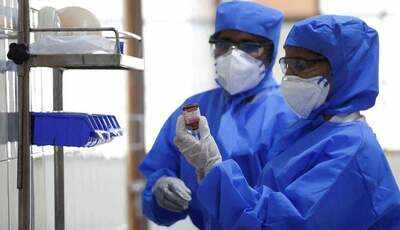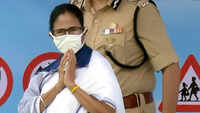
THIRUVANANTHAPURAM: Kumarichantha, which is assumed as the origin of multiple clusters in three coastal wards in the capital, may have set off the transmission chain with a potent combo of crowding and loud speech, said infectious disease experts.
Large transmission clusters – reported recently in Washington, South Korea – emerged from high-risk settings where people shouted or sang; ascertaining studies which showed that oral fluid droplets released during normal and loud speech in crowded environments transmitted the virus. A good percentage of persons who tested positive in the three coastal wards had direct contact with the market and became positive more or less in the same timeline.
Coronavirus super spreading events in South Korea and Washington had its origin in choir meetings. “Kumarichantha being a crowded market, people talk in high-pitched voices, while trying to sell stuff. This is equivalent to a choir in terms of generating aerosols like the incident in Washington or South Korea. It could be the case of small particle aerosol transmission. It was not a case of super spreader but a super spreading event that is unravelling in coastal wards,” said an infectious disease expert associated with Covid management in the state.
While airborne transmission is mostly associated with confined environments, lack of social distancing, negligence in using masks coupled with crowding and high pitched speech would have made matters different in Kumarichantha, officials said.
An article published in Nature magazine on the relation between aerosol emission, super emission, human speech and voice loudness mentioned how a fraction of individuals behave as speech super emitters when they release more particles than their peers. The study showed that smaller particles emitted during breathing and talking are less noticeable but arguably more-infectious because despite their small size, they are sufficiently large to carry a variety of respiratory pathogens.
Officials said that it is not just the case of Kumarichantha; crowds in places which are highly-vulnerable, especially markets, could be potentially-risky for widespread transmission.
“In many cases, people could be asymptomatic, so we can’t look out just for people who sneeze or cough. Silent carriers could also emit oral fluids with viral load during normal speech and when they talk loudly in a high-risk setting, the danger is amplified. It strongly emphasizes the need for constant use of masks which could ward off the possibilities of large-scale transmission,” said an official.
A recent study published in the journal of National Academy of Sciences of the United States of America shows that speech droplets generated by asymptomatic carriers of severe acute respiratory syndrome coronavirus 2 (SARS-CoV-2) are increasingly considered to be a likely mode of disease transmission. Highly sensitive laser light scattering observations revealed that loud speech can emit thousands of oral fluid droplets per second, the study noted.
Large transmission clusters – reported recently in Washington, South Korea – emerged from high-risk settings where people shouted or sang; ascertaining studies which showed that oral fluid droplets released during normal and loud speech in crowded environments transmitted the virus. A good percentage of persons who tested positive in the three coastal wards had direct contact with the market and became positive more or less in the same timeline.
Coronavirus super spreading events in South Korea and Washington had its origin in choir meetings. “Kumarichantha being a crowded market, people talk in high-pitched voices, while trying to sell stuff. This is equivalent to a choir in terms of generating aerosols like the incident in Washington or South Korea. It could be the case of small particle aerosol transmission. It was not a case of super spreader but a super spreading event that is unravelling in coastal wards,” said an infectious disease expert associated with Covid management in the state.
While airborne transmission is mostly associated with confined environments, lack of social distancing, negligence in using masks coupled with crowding and high pitched speech would have made matters different in Kumarichantha, officials said.
An article published in Nature magazine on the relation between aerosol emission, super emission, human speech and voice loudness mentioned how a fraction of individuals behave as speech super emitters when they release more particles than their peers. The study showed that smaller particles emitted during breathing and talking are less noticeable but arguably more-infectious because despite their small size, they are sufficiently large to carry a variety of respiratory pathogens.
Officials said that it is not just the case of Kumarichantha; crowds in places which are highly-vulnerable, especially markets, could be potentially-risky for widespread transmission.
“In many cases, people could be asymptomatic, so we can’t look out just for people who sneeze or cough. Silent carriers could also emit oral fluids with viral load during normal speech and when they talk loudly in a high-risk setting, the danger is amplified. It strongly emphasizes the need for constant use of masks which could ward off the possibilities of large-scale transmission,” said an official.
A recent study published in the journal of National Academy of Sciences of the United States of America shows that speech droplets generated by asymptomatic carriers of severe acute respiratory syndrome coronavirus 2 (SARS-CoV-2) are increasingly considered to be a likely mode of disease transmission. Highly sensitive laser light scattering observations revealed that loud speech can emit thousands of oral fluid droplets per second, the study noted.
Quick Links
Kerala Coronavirus Helpline NumberHaryana Coronavirus Helpline NumberUP Coronavirus Helpline NumberBareilly NewsBhopal NewsCoronavirus in DelhiCoronavirus in HyderabadCoronavirus in IndiaCoronavirus symptomsCoronavirusRajasthan Coronavirus Helpline NumberAditya ThackerayShiv SenaFire in MumbaiAP Coronavirus Helpline NumberArvind KejriwalJammu Kashmir Coronavirus Helpline NumberSrinagar encounter
Get the app








